
Outline of Western Culture:A Brief Introduction Public Administration College:Zhongze Zhu 1.The basic information of the course(课程基本信息) Course Code(课程代码):16091203 Course Name(课程名称):Western Culture::ABrief Introduction Course Type(课程类别:Specialized Direction Course for the Subject of Cultural Industry Management Period(学时):48 hours Credit(学分):3 Assess Type(考核方式):classroom test 2.Course Description(课程简介) This course focuses on the Western tradition of humanitarian and intellectual development which is represented by a large group of the who came to the fore and helped to change greatly the social and cultural circumstances in areas of knowledge.such as socioly,philosophy.onmspsychology,booyanthropology,art and literature.This elite ranged from Socrates,Plato and Aristotle,to Dante,Shakespeare Locke.Francis Bacon,Voltaire,Rousseau,I.Kant,Hegel,Betham.John Mill,Marx,Engels, Charles Darwin,Auguste Comte.Schopenhauer,Netzsche,Sigmund,Jung.Bergson,Einstein and Jean-Paul Sartre etc. 3.Requirements and Grading(教学要求与考核评分标准) Readings:西方文化概论,方汉文著,中国人民大学出版社 Routine:worth total grade 40%(including midterm exam 30%,attendance 15%. discussion 15%,assignment40%) Final Exam:worth total grade 60%. Group work:main method to learn
1 Outline of Western Culture: A Brief Introduction Public Administration College: Zhongze Zhu 1.The basic information of the course(课程基本信息) Course Code (课程代码):16091203 Course Name(课程名称):Western Culture: A Brief Introduction Course Type(课程类别):Specialized Direction Course for the Subject of Cultural Industry Management Period (学时):48 hours Credit (学分):3 Assess Type (考核方式):classroom test 2. Course Description (课程简介) This course focuses on the Western tradition of humanitarian and intellectual development, which is represented by a large group of the selected intellectual elite who came to the fore and helped to change greatly the social and cultural circumstances in areas of knowledge, such as sociology, philosophy, economics, psychology, biology, anthropology, art and literature. This elite ranged from Socrates, Plato and Aristotle, to Dante, Shakespeare, Locke, Francis Bacon, Voltaire, Rousseau, I. Kant, Hegel, Betham, John Mill, Marx, Engels, Charles Darwin, Auguste Comte, Schopenhauer, Nietzsche, Sigmund, Jung, Bergson, Einstein and Jean-Paul Sartre etc. 3. Requirements and Grading(教学要求与考核评分标准) Readings:西方文化概论,方汉文著, 中国人民大学出版社 Routine: worth total grade 40% (including midterm exam 30%, attendance 15%, discussion 15%, assignment 40%). Final Exam: worth total grade 60%. Group work: main method to learn. Attitude: academic honesty
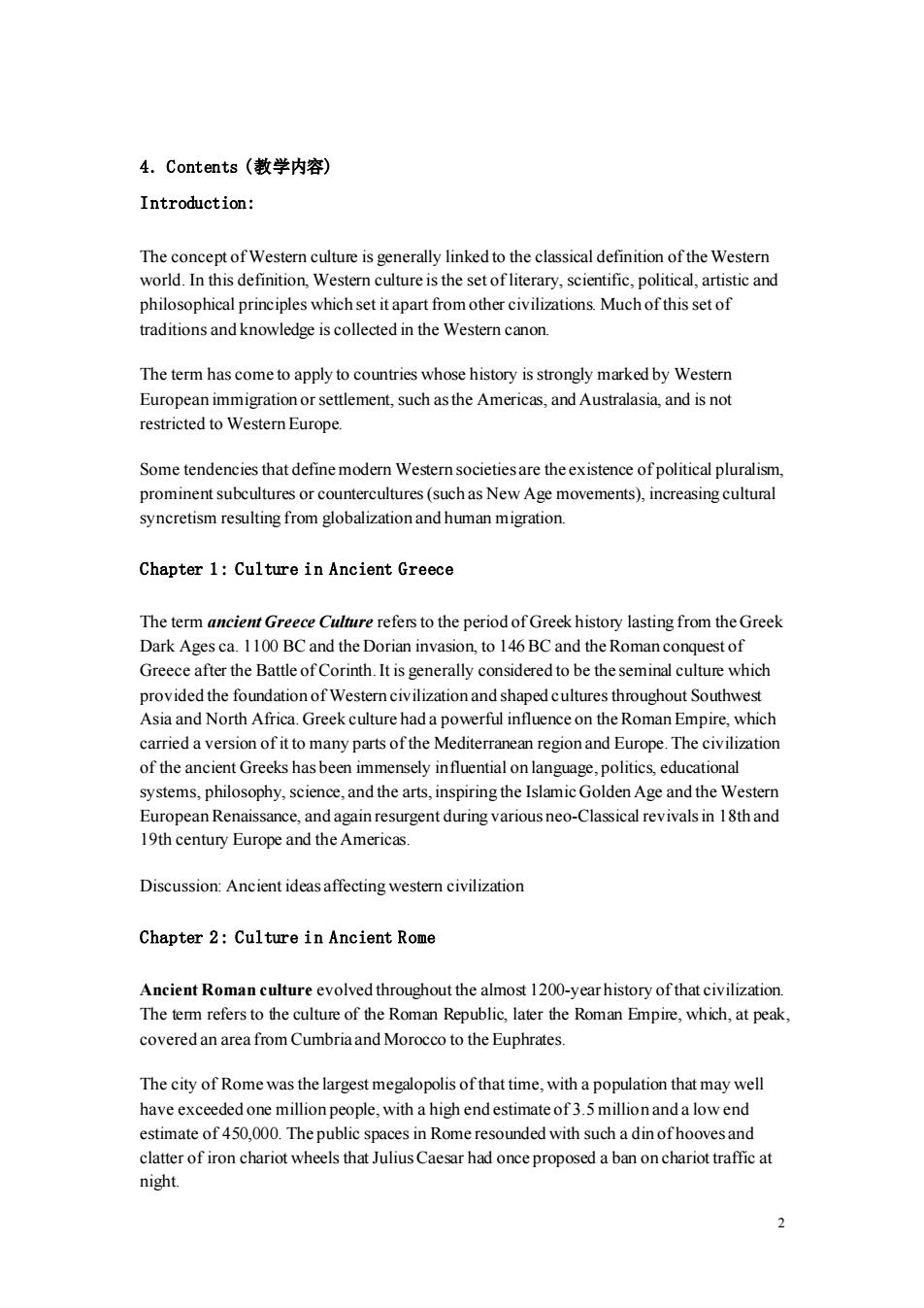
4.Contents(教学内容) Introduction: The concept of Western culture is generally linked to the classical definition of the Western world.In this definition Western culture is the setof literary,scientific,political,artistic and philosophical principles which set it apart fromother civilizations Much ofthis set of traditions and knowledge iscollected in the Westem canon. The term has come to apply to countries whose history is strongly marked by Western European immigration or settlement,such as the Americas.and Australasia.and is not restricted to Western Europe. Some tendencies that define modern Western societiesare the existence of political pluralism prominent ercultures(suchas New Age syncretism from human migration. Chapter 1:Culture in Ancient Greece The term ancient Greece Culture refers to the period of Greek history lasting from the Greek Dark Ages ca.1100 BC and the Dorian invasion,to 146 BC and the Roman conquest of Greece after the Battle of Corinth.It is generally considered to be the seminal culture which rovided ization and sha ed cultures throughout Southwe Asia and North Africa.Greek culture had a powerful influence on the Roman Empire,which carried a version ofit to many parts of the Mediterranean region and Europe.The civilization of the ancient Greeks has been immensely influential on language,politics,educational systems,philosophy,science,and the arts,inspiring the IslamicGolden Age and the Wester and again variouso-Clasicl revivals in 18thand Discussion:Ancient ideasaffecting western civilization Chapter 2:Culture in Ancient Rome Ancient Roman culture evolved throughout the almost 1200-year history of that civilization. The term referstothe of the Roman Republic,later the Roman Empire,which,at peak covered an area from Cumbriaand Morocco to the Euphrates. The city of Rome was the largest megalopolis ofthat time.with a population that may wel have exceeded one million people,with a high end estimate of 3.5 millionand a low end estimate of 450,000.The public spaces in Rome resounded with such a din ofhoovesand clatter of iron chariot wheels that JuliusCaesar had once proposed a ban onchariot traffic at night
2 4. Contents (教学内容) Introduction: The concept of Western culture is generally linked to the classical definition of the Western world. In this definition, Western culture is the set of literary, scientific, political, artistic and philosophical principles which set it apart from other civilizations. Much of this set of traditions and knowledge is collected in the Western canon. The term has come to apply to countries whose history is strongly marked by Western European immigration or settlement, such as the Americas, and Australasia, and is not restricted to Western Europe. Some tendencies that define modern Western societies are the existence of political pluralism, prominent subcultures or countercultures (such as New Age movements), increasing cultural syncretism resulting from globalization and human migration. Chapter 1: Culture in Ancient Greece The term ancient Greece Culture refers to the period of Greek history lasting from the Greek Dark Ages ca. 1100 BC and the Dorian invasion, to 146 BC and the Roman conquest of Greece after the Battle of Corinth. It is generally considered to be the seminal culture which provided the foundation of Western civilization and shaped cultures throughout Southwest Asia and North Africa. Greek culture had a powerful influence on the Roman Empire, which carried a version of it to many parts of the Mediterranean region and Europe. The civilization of the ancient Greeks has been immensely influential on language, politics, educational systems, philosophy, science, and the arts, inspiring the Islamic Golden Age and the Western European Renaissance, and again resurgent during various neo-Classical revivals in 18th and 19th century Europe and the Americas. Discussion: Ancient ideas affecting western civilization Chapter 2: Culture in Ancient Rome Ancient Roman culture evolved throughout the almost 1200-year history of that civilization. The term refers to the culture of the Roman Republic, later the Roman Empire, which, at peak, covered an area from Cumbria and Morocco to the Euphrates. The city of Rome was the largest megalopolis of that time, with a population that may well have exceeded one million people, with a high end estimate of 3.5 million and a low end estimate of 450,000. The public spaces in Rome resounded with such a din of hooves and clatter of iron chariot wheels that Julius Caesar had once proposed a ban on chariot traffic at night
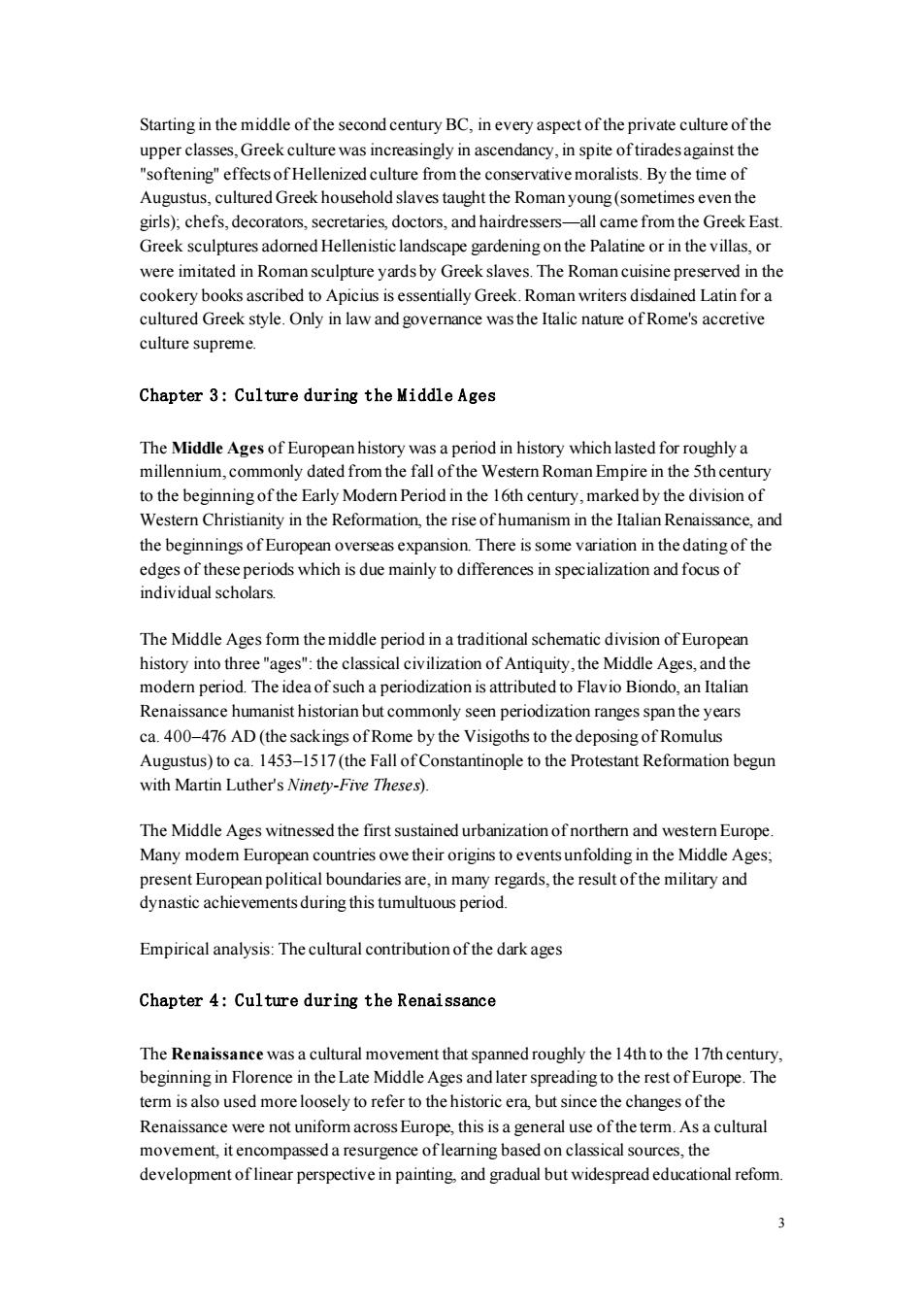
Starting in the middle of the second century BC.in every aspect of the private culture of the Augustus,cultured Greek houschold slaves taught the Roman young(sometimes even the girls),chefs,decorators,secretaries,doctors,and hairdressers-all came from the Greek East Greek sculptures adorned Hellenistic landscape gardening on the Palatine or in the villas.or were imitat d in Ron an sculpture yardsby Greek slaves.The Roman cuisin e pr rved in th cookery books as ribed to Apicius isessentially Greek R oman writers dis ained Latin for a cultured Greek style.Only in law and governance was the Italic nature of Rome's accretive culture supreme. Chapter 3:Culture during the Middle Ages The Middle Ages of Eu an histo milennium, th e Western Roman Empire e in the th centur to the beginning of the Early Modern Period in the 16th century,marke d by the division of Western Christianity in the Reformation,the rise of humanism in the Italian Renaissance.and the beginnings of European overseas expansion.There is some variation in the dating of the of these periods which is due mainly to differences in specialization and focus of The Middle Ages fom themiddle periodin atraditional schematic division of European history into three "ages":the classical civilization of Antiquity.the Middle Ages.and the modern period.The idea of such a periodization is attributed to Flavio Biondo,an Italian Renaissance humanist historian but commonly seen periodization ranges span the years ca 00-476 AD(the sackings of Rome by the Visigo ths to the deposi ing of Romulus Augustus)toc 453-1517(the Fall of Constantinople to th e Protestan formation begur with Martin Luther's Ninety-Five Theses). The Middle Ages witnessed the first sustained urbanization of northern and western Europe Many modem European countries owe their origins to eventsunfolding in the Middle Ages. present European political boundaries are,in many regards,the result ofthe military and ynasticachie entsduring thistumultuous period. Empirical analysis:The cultural contribution of the dark ages Chapter 4:Culture during the Renaissance The Renaissance was a cultural movement that spanned roughly the 14th to the 17th century. beginning in Florence in the Late Middle Ages and later spreading to the rest of Europe.The term is also used moreloosely to refer to the historic era but since the changes ofthe Renaissance were notuniformacross Europe,this is a general movement,it encompassed a resurgence of learning bas development of linear perspective in painting and gradual but widespread educational refom. 3
3 Starting in the middle of the second century BC, in every aspect of the private culture of the upper classes, Greek culture was increasingly in ascendancy, in spite of tirades against the "softening" effects of Hellenized culture from the conservative moralists. By the time of Augustus, cultured Greek household slaves taught the Roman young (sometimes even the girls); chefs, decorators, secretaries, doctors, and hairdressers—all came from the Greek East. Greek sculptures adorned Hellenistic landscape gardening on the Palatine or in the villas, or were imitated in Roman sculpture yards by Greek slaves. The Roman cuisine preserved in the cookery books ascribed to Apicius is essentially Greek. Roman writers disdained Latin for a cultured Greek style. Only in law and governance was the Italic nature of Rome's accretive culture supreme. Chapter 3: Culture during the Middle Ages The Middle Ages of European history was a period in history which lasted for roughly a millennium, commonly dated from the fall of the Western Roman Empire in the 5th century to the beginning of the Early Modern Period in the 16th century, marked by the division of Western Christianity in the Reformation, the rise of humanism in the Italian Renaissance, and the beginnings of European overseas expansion. There is some variation in the dating of the edges of these periods which is due mainly to differences in specialization and focus of individual scholars. The Middle Ages form the middle period in a traditional schematic division of European history into three "ages": the classical civilization of Antiquity, the Middle Ages, and the modern period. The idea of such a periodization is attributed to Flavio Biondo, an Italian Renaissance humanist historian but commonly seen periodization ranges span the years ca. 400–476 AD (the sackings of Rome by the Visigoths to the deposing of Romulus Augustus) to ca. 1453–1517 (the Fall of Constantinople to the Protestant Reformation begun with Martin Luther's Ninety-Five Theses). The Middle Ages witnessed the first sustained urbanization of northern and western Europe. Many modern European countries owe their origins to events unfolding in the Middle Ages; present European political boundaries are, in many regards, the result of the military and dynastic achievements during this tumultuous period. Empirical analysis: The cultural contribution of the dark ages Chapter 4: Culture during the Renaissance The Renaissance was a cultural movement that spanned roughly the 14th to the 17th century, beginning in Florence in the Late Middle Ages and later spreading to the rest of Europe. The term is also used more loosely to refer to the historic era, but since the changes of the Renaissance were not uniform across Europe, this is a general use of the term. As a cultural movement, it encompassed a resurgence of learning based on classical sources, the development of linear perspective in painting, and gradual but widespread educational reform
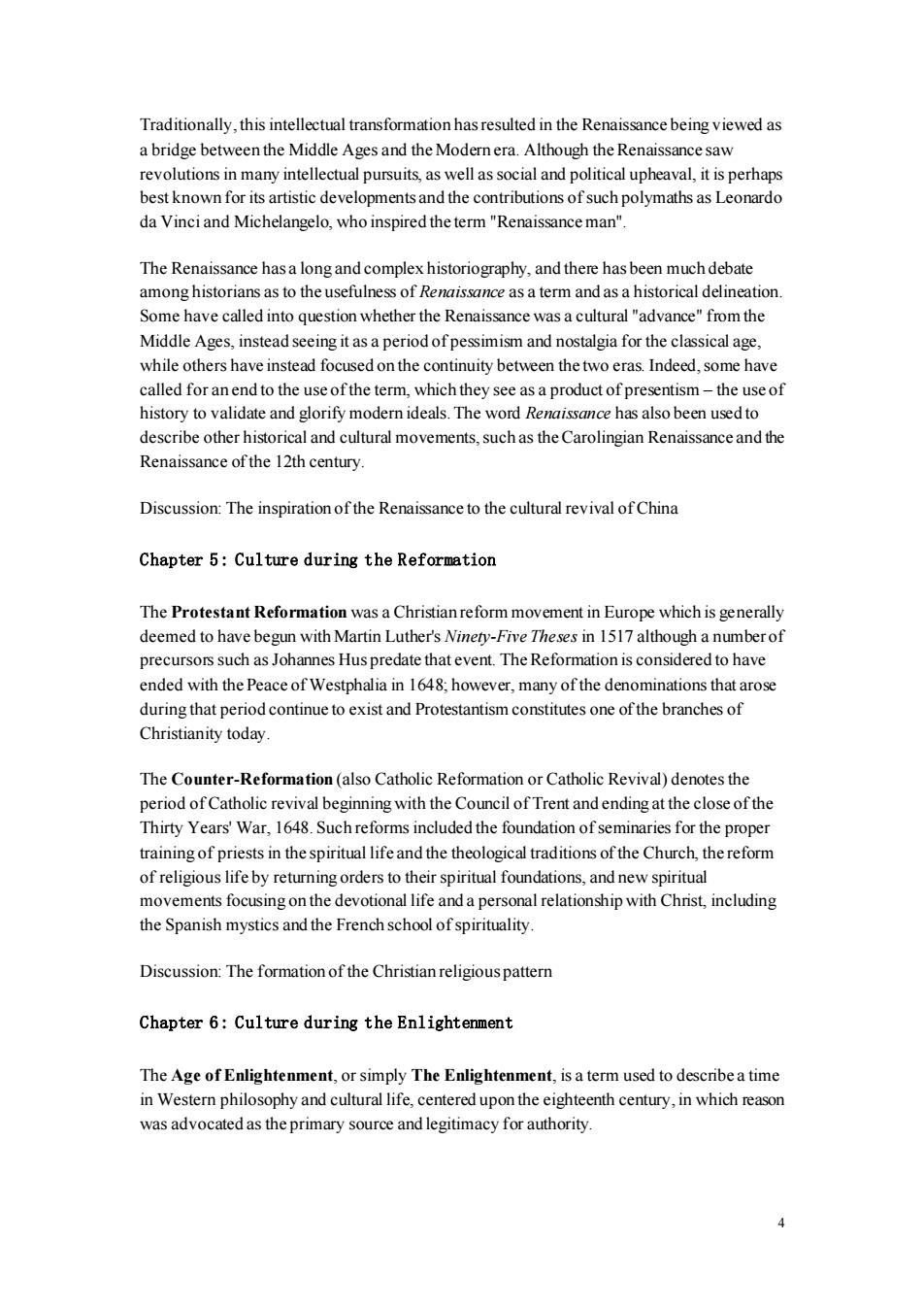
Traditionally,this intellectual transformation hasresulted in the Renaissance being viewed as a bridge between the Middle Ages and the Modemera.Although the Renaissancesaw best known for its artistic developments and the contributions of such polymaths as Leonard da Vinci and Michelangelo.who inspired the term "Renaissance man" The Renaissance hasa long and complex historiography,and there has been much debate among historians as to the usefulness of rengissance as a term and as a historical delineation Some have called into question whether the Renaissance"advance"from the Middle Ages,instead seeingitasa period ofpessimism and nostalgia for the classicalage while others have instead focused on the continuity between the two eras Indeed,some have called for anend to the use ofthe term,which they see as a product of presentism-the use of history to validate and glorify modernideals.The word Renaissance has also been usedto describe other historical and cultural movements,such as the Carolingian Renaissance and the Renaissance ofthe 12th century Discussion:The inspiration of the Renaissance to the cultural revival of China Chapter 5:Culture during the Reformation The protestant reformation was a christian reform movement in eurone which is generally deemed to have begun with Martin Luther's Ninety-Five Theses in 1517 although a numberof ors such as Johannes Hu that e vent The Reformation is nsidered to have ethe Peace of Westhai n 16t5.Fowever mnyofhe dom during that period continue to exist and Protestantism constitutes one of the branches of Christianity today. The Counter-Reformation(also Catholic Reformation or Catholic Revival)denotes the period of Catholic revival beginning with the Council of Trent and ending at the close of the training of priests in the spiritual life and the theological traditions of the Church,the reform of religious life by returning orders to their spiritual foundations,and new spiritual movements focusing on the devotional life anda personal relationship with Christ,including the Spanish mystics and the French school ofspirituality. Discussion The formation of the Christian religiouspattern Chapter 6:Culture during the Enlightenment The Age of Enlightenment,or simply The Enlightenment,is a term used to describea time in Western philosophy and cultural life,centered upon the eighteenth century,in which reason was advocated as the primary source and legitimacy for authority
4 Traditionally, this intellectual transformation has resulted in the Renaissance being viewed as a bridge between the Middle Ages and the Modern era. Although the Renaissance saw revolutions in many intellectual pursuits, as well as social and political upheaval, it is perhaps best known for its artistic developments and the contributions of such polymaths as Leonardo da Vinci and Michelangelo, who inspired the term "Renaissance man". The Renaissance has a long and complex historiography, and there has been much debate among historians as to the usefulness of Renaissance as a term and as a historical delineation. Some have called into question whether the Renaissance was a cultural "advance" from the Middle Ages, instead seeing it as a period of pessimism and nostalgia for the classical age, while others have instead focused on the continuity between the two eras. Indeed, some have called for an end to the use of the term, which they see as a product of presentism – the use of history to validate and glorify modern ideals. The word Renaissance has also been used to describe other historical and cultural movements, such as the Carolingian Renaissance and the Renaissance of the 12th century. Discussion: The inspiration of the Renaissance to the cultural revival of China Chapter 5: Culture during the Reformation The Protestant Reformation was a Christian reform movement in Europe which is generally deemed to have begun with Martin Luther's Ninety-Five Theses in 1517 although a number of precursors such as Johannes Hus predate that event. The Reformation is considered to have ended with the Peace of Westphalia in 1648; however, many of the denominations that arose during that period continue to exist and Protestantism constitutes one of the branches of Christianity today. The Counter-Reformation (also Catholic Reformation or Catholic Revival) denotes the period of Catholic revival beginning with the Council of Trent and ending at the close of the Thirty Years' War, 1648. Such reforms included the foundation of seminaries for the proper training of priests in the spiritual life and the theological traditions of the Church, the reform of religious life by returning orders to their spiritual foundations, and new spiritual movements focusing on the devotional life and a personal relationship with Christ, including the Spanish mystics and the French school of spirituality. Discussion: The formation of the Christian religious pattern Chapter 6: Culture during the Enlightenment The Age of Enlightenment, or simply The Enlightenment, is a term used to describe a time in Western philosophy and cultural life, centered upon the eighteenth century, in which reason was advocated as the primary source and legitimacy for authority
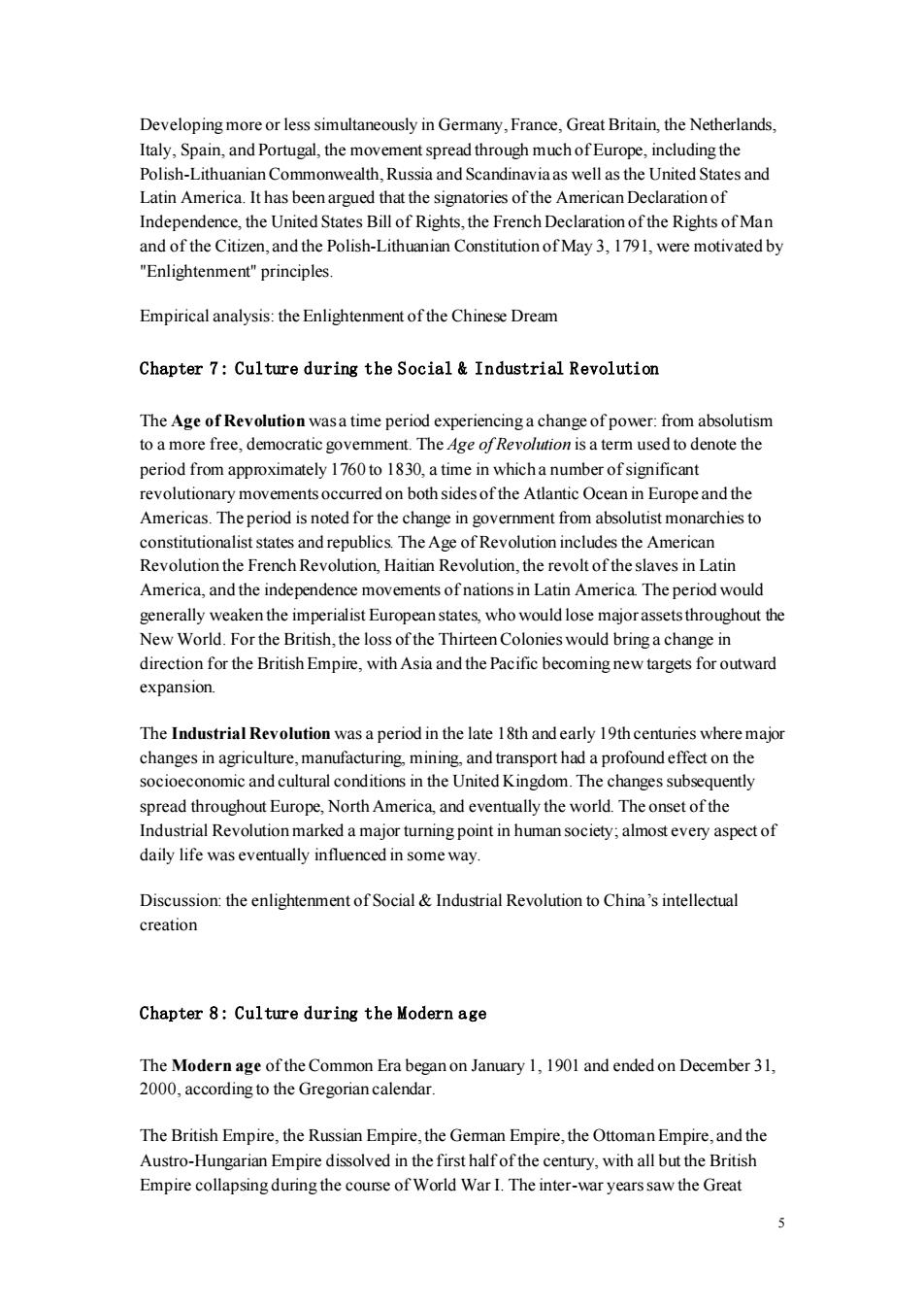
Developing more or less simultaneously in Germany.france.Great Britain the Netherlands ain,and Portugal,the mo ovement spread thr ough much of Europe,including the PtCommoneat.Rusta and Scandinvinas well asth United States and Latin America.It has been argued that the signatories of the American Declaration of Independence,the United States Bill of Rights,the French Declaration of the Rights of Man and of the Citizen.and the Polish-Lithuanian Constitution of May 3.1791.were motivated by "Enlightenment"principles Empirical analysis:the Enlightenment of the Chinese Dream Chapter 7:Culture during the Social Industrial Revolution The Age of Revolution wasa time period experiencing a change of power:from absolutism to a more free,democratic govemment.The Age ofRevolution is a term used to denote the period from approximately 1760 to 1830,a time in whicha number of significant nts occu redon bothsidesof the Atlantic Ocean in Europe and the Americas.The period is noted for the change in government from absolutist monarchies to constitutionalist states and republics.The Age of Revolution includes the American Revolution the french revolution.haitian revolution.the revolt of the slaves in latin America.and the independence movements of nations in Latin America The period would erialist Eur eanstates,who would lose majorassetsthroughout h ord.FortheBritish,the oss ofthhrtnColooudng direction for the British Empire.with Asia and the Pacific becoming new targets for outward expansion. The Industrial Revolution was a period in the late 18th and early 19th centuries where major socio nom s in the United Kir dom.The changes su equently spread throughout Europe,North America,and eventually the world.The onset of the Industrial Revolution marked a major turning point in human society:almost every aspect of daily life was eventually influenced in some way. Discussion:the enlightenment of Social&Industrial Revolution to China's intellectual creation Chapter 8:Culture during the Modern ag The Modern age of the Common Era began on January 1,1901 and ended on December 31, 2000.according to the Gregorian calendar. The British Empire,the Russian Empire.the Geman Empire,the Ottoman Empire,and the Austro-Hungarian Empire dissolved in the first halfof the century,with all but the British Empire collapsing during the course of World War I.The inter-war years saw the Great
5 Developing more or less simultaneously in Germany, France, Great Britain, the Netherlands, Italy, Spain, and Portugal, the movement spread through much of Europe, including the Polish-Lithuanian Commonwealth, Russia and Scandinavia as well as the United States and Latin America. It has been argued that the signatories of the American Declaration of Independence, the United States Bill of Rights, the French Declaration of the Rights of Man and of the Citizen, and the Polish-Lithuanian Constitution of May 3, 1791, were motivated by "Enlightenment" principles. Empirical analysis: the Enlightenment of the Chinese Dream Chapter 7: Culture during the Social & Industrial Revolution The Age of Revolution was a time period experiencing a change of power: from absolutism to a more free, democratic government. The Age of Revolution is a term used to denote the period from approximately 1760 to 1830, a time in which a number of significant revolutionary movements occurred on both sides of the Atlantic Ocean in Europe and the Americas. The period is noted for the change in government from absolutist monarchies to constitutionalist states and republics. The Age of Revolution includes the American Revolution the French Revolution, Haitian Revolution, the revolt of the slaves in Latin America, and the independence movements of nations in Latin America. The period would generally weaken the imperialist European states, who would lose major assets throughout the New World. For the British, the loss of the Thirteen Colonies would bring a change in direction for the British Empire, with Asia and the Pacific becoming new targets for outward expansion. The Industrial Revolution was a period in the late 18th and early 19th centuries where major changes in agriculture, manufacturing, mining, and transport had a profound effect on the socioeconomic and cultural conditions in the United Kingdom. The changes subsequently spread throughout Europe, North America, and eventually the world. The onset of the Industrial Revolution marked a major turning point in human society; almost every aspect of daily life was eventually influenced in some way. Discussion: the enlightenment of Social & Industrial Revolution to China’s intellectual creation Chapter 8: Culture during the Modern age The Modern age of the Common Era began on January 1, 1901 and ended on December 31, 2000, according to the Gregorian calendar. The British Empire, the Russian Empire, the German Empire, the Ottoman Empire, and the Austro-Hungarian Empire dissolved in the first half of the century, with all but the British Empire collapsing during the course of World War I. The inter-war years saw the Great
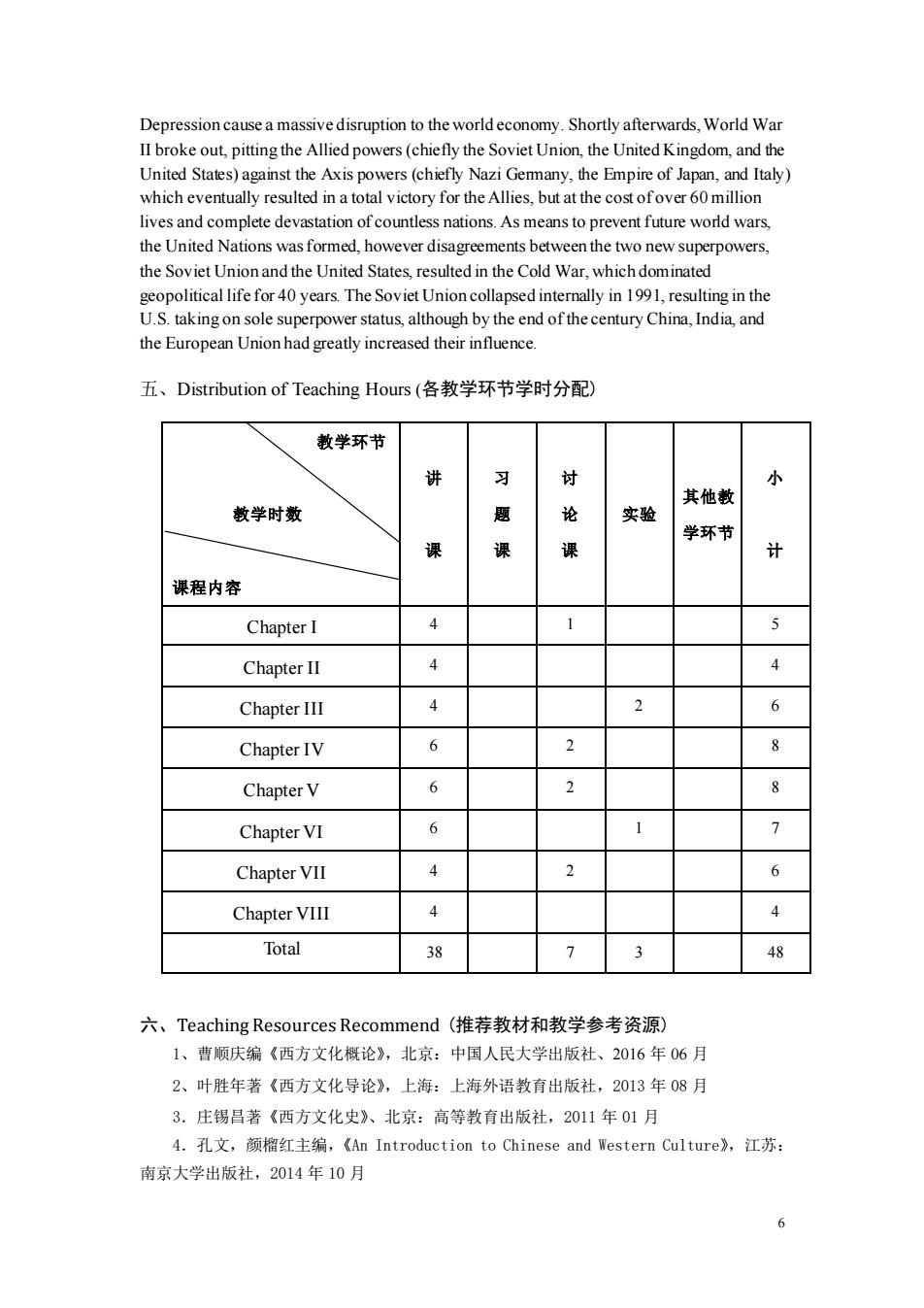
Depression cause a massive disruption to the world economy.Shortly afterwards,World War II brokeou pitting the Allied powers (chiefly the,the United Kingdom,and the United Staes)against the Axis powers(chiefly NaziGe n,and Italy which eventually na total victory for theAllies,but at the o lives and complete devastation of countless nations.As means to prevent future world wars. the United Nations was formed,however disagreements between the two new superpowers, the Soviet Unionand the United States,resulted in the Cold War,which dominated poliealle40yarsies3o on collapsed inte nally in in the takingon sole superpower status although by the end ofthe century China,India and the European Union had greatly increased their influence. 五、Distribution of Teaching Hours(各教学环节学时分配) 敕学环节 普 9 或 其他 教学时数 论 实验 学环节 课 课 课 课程内容 ChapterI 4 1 Chapter II 4 ChapterIII 4 2 6 ChapterIV 6 2 ChapterV 6 2 Chapter VI 1 7 Chapter VII Chapter VIII Total 38 六、Teaching Resources Recommend(推荐教材和教学参考资源) 1、曹顺庆编《西方文化概论》,北京:中国人民大学出版社、2016年06月 2、叶胜年著《西方文化导论》,上海:上海外语教有出版社,2013年08月 3.庄锡昌著《西方文化史》、北京:高等教有出版社,2011年01月 4.孔文,颜榴红主编,《An Introduction to Chinese and Western Culture》,江苏: 南京大学出版社,2014年10月 6
6 Depression cause a massive disruption to the world economy. Shortly afterwards, World War II broke out, pitting the Allied powers (chiefly the Soviet Union, the United Kingdom, and the United States) against the Axis powers (chiefly Nazi Germany, the Empire of Japan, and Italy) which eventually resulted in a total victory for the Allies, but at the cost of over 60 million lives and complete devastation of countless nations. As means to prevent future world wars, the United Nations was formed, however disagreements between the two new superpowers, the Soviet Union and the United States, resulted in the Cold War, which dominated geopolitical life for 40 years. The Soviet Union collapsed internally in 1991, resulting in the U.S. taking on sole superpower status, although by the end of the century China, India, and the European Union had greatly increased their influence. 五、Distribution of Teaching Hours (各教学环节学时分配) 教学环节 教学时数 课程内容 讲 课 习 题 课 讨 论 课 实验 其他教 学环节 小 计 Chapter I 4 1 5 Chapter II 4 4 Chapter III 4 2 6 Chapter IV 6 2 8 Chapter V 6 2 8 Chapter VI 6 1 7 Chapter VII 4 2 6 Chapter VIII 4 4 Total 38 7 3 48 六、Teaching Resources Recommend (推荐教材和教学参考资源) 1、曹顺庆编《西方文化概论》,北京:中国人民大学出版社、2016 年 06 月 2、叶胜年著《西方文化导论》,上海:上海外语教育出版社,2013 年 08 月 3.庄锡昌著《西方文化史》、北京:高等教育出版社,2011 年 01 月 4.孔文,颜榴红主编,《An Introduction to Chinese and Western Culture》,江苏: 南京大学出版社,2014 年 10 月

七、Other Information(其他说明) 大纲修订人:朱忠泽 修订日期:2013.3.18 大纲审定人: 审定日期: 1
7 七、Other Information(其他说明) 大纲修订人: 朱忠泽 修订日期:2013.3.18 大纲审定人: 审定日期: